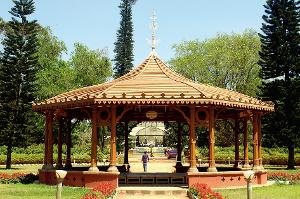Researching historical details can get confusing at times. This story for instance, begins in a Scottish city called Glasgow on a street named after the Saracen people from the Middle Ages. It then gets directed to a Victorian bandstand in a historic park laid out by a military engineer in South India’s tech-hub, Bengaluru. And if you think it’s quite knotted up already, that’s not the end of it. But maybe that’s also the fun of it.
Parks historian and author Paul Rabbitts says that the bandstand (or `band house’ as it was first called) was perhaps inspired by popular 18th century pleasure gardens like Vauxhall in London who also offered music pavilions and exotic entertainment including hot air balloons, tightrope walkers and fireworks. The bandstands were envisioned as a decorative focal point for the park and provided acoustic shelter for the brass, wind and military bands that played there. Their rich decorative elements and curved shapes also seemed to reflect oriental influences like the pagodas and chattri’s from the eastern corners of the empire. The first domed structure was reportedly built in 1861 at the Royal Horticultural Society, South Kensington. The concept soon captured the imagination of 19th century Britain where he says, approximately 1,200 bandstands were built between 1860 and WWII. Though these public parks were primarily designed for relaxation, they were also interpreted as an attempt to `humanise’ the grim townscapes that emerged during the Industrial Revolution.
The Cubbon Park bandstand with its traditional octagonal shape sits on the same axis as the Vidhana Soudha, Attara Kacheri and Government Museum. It is said to have been gifted to the park in 1914 by Nalwadi Krishnaraja Wodeyar IV, the Maharaja of Mysore and initially placed near the Seshadri Iyer Memorial Hall. It was shifted to its current location in 1937, over what was once called the Ringwood Circle.
Iron was strong, durable but light. Molten iron could also be poured into pre-fabricated moulds. This enabled accurate replication and extensive repetition. `Cast’ iron therefore became popular for ornamental and commercial purposes. The framework for Cubbon Park’s cast iron bandstand took shape in the Glasgow based Saracen Foundry, owned by architectural iron casters Walter Macfarlane and Company Ltd. The company was set up in a disused brass foundry on Saracen Street in 1851 and soon became a famous designer-manufacturer of ornamental fountains, park and garden seats, conservatories, flower vases, baths, pipes and fittings right up till WWII.
Bandstands fell out of favour following WWII but iconic Macfarlane and Co. Ltd cast iron designs were still spotted around the world. They included the main (northern side) entrance gates to Lalbagh and the conservatory style Glass House.
The Lalbagh bandstand is believed to have been conceptualised during the tenure of Superintendent Mr. William New (1854-1864). He organised the first few `Lalbagh Shows’ around it in the late 1860’s before the Glass House came up in 1890. Mr. John Cameron who succeeded New in 1874 recorded its repair and renovation; a granite platform was also added and the wooden roof was improved.
Old timers recall orchestras and military bands playing regularly at bandstands in the city, including Cole’s Park, while city chronicler Mrs Maya Jayapal mentions that live music was scheduled for the fourth Thursday of every month in the 1920’s. The bandstands now accommodate deep breathing pranayama practitioners in the morning, sleeping somari’s in the afternoon and performances by local school children and classical musicians on weekends. It’s always fascinating to see how our local history runs alongside, intersects with or unites stories of people and places around the world.
The writer is a cultural documentarian and blogs at aturquoisecloud.wordpress.com
source: http://www.bangaloremirror.com / Bangalore Mirror / Home> Columns> Others / by Aliyeh Rizvi, Bangalore Mirror Bureau / June 26th, 2016
